|


_____________
In this section of
Gaspee History

_____________
Go to
Gaspee Raiders
for biographical
information on the Americans in the boats attacking the Royal Navy ship
Gaspee.
_____________
Books: American Colonial and
Revolutionary War history or the people involved. We have suggestions
for you.

_____________
Copyrighted.
© 2005
to 08/22/2010
Leonard H. Bucklin.
-----
The
content of this site may not be reproduced except for brief excerpts for
reviews or scholarly references..
See
Copyright Notices,
Privacy Policy, and Warnings & Disclaimers.
_____________

This is a history education and
research web site of the
Joseph Bucklin Society.
 References
in brackets [ ] or in curly brackets { } on any page in
this website are to books, or other materials, listed in the Joseph
Bucklin Society Gaspee Bibliography, or to materials held by the Joseph
Bucklin Society. References
in brackets [ ] or in curly brackets { } on any page in
this website are to books, or other materials, listed in the Joseph
Bucklin Society Gaspee Bibliography, or to materials held by the Joseph
Bucklin Society.
|

|
The following is a partial list of persons
who figured in
the events of the Gaspee Attack
--- but who were not in the boats
attacking the Gaspee.
We
do not attempt to maintain a comprehensive discussion of the many persons
involved in colonial or revolutionary activities before or after the Gaspee
attack in Rhode Island in 1772. This site focuses on the Gaspee raiders
themselves and the events in the Gaspee attack.
The purpose of this page is to provide links to discussions of
persons involved and about which some information is helpful to a complete
understanding of the events that formed the Gaspee attack and the events that
came as a reaction to the attack, or give you basic information about who they
were and basically how they were involved in the Gaspee attack.
Auchuty, Robert, Jr. Judge Auchuty was the Judge of the Vice-Admiralty Court for New
Hampshire, Massachusetts, Rhode Island and Connecticut, and a member of the
Royal Commission of Inquiry investigating the Gaspee affair.
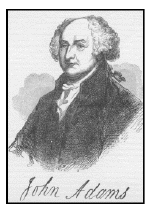 Adams, John Adams, John
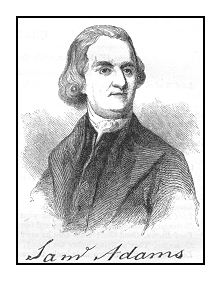 Adams, Samuel
Samuel Adams was one of the main advocates of revolution. He was one of the
earliest advocate of the Americans leaving the English kingdom, and has been one
of the most famous, from 1770 to the present. Adams, Samuel
Samuel Adams was one of the main advocates of revolution. He was one of the
earliest advocate of the Americans leaving the English kingdom, and has been one
of the most famous, from 1770 to the present.
Allen, John. John Allen was an important Boston minister.
Shortly after the Gaspee attack he delivered a sermon which because a clearly
stated and popular version of the doctrine of American rights versus the English
view of colonial rights. That sermon was titled "An
Oration Upon the Beauty of Liberty, Or the Essential Rights of Americans."
This sermon was printed and widely distributed. The sermon
protested England's reaction in the Gaspee case and argued that England and America were
separate legal jurisdictions. This idea became revolutionary doctrine
during the war after 1775.
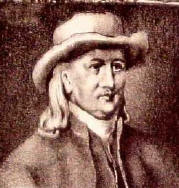 Hopkins, Stephen
.Stephen Hopkins was a great grandson of Captain John Whipple,
and hence Stephen was a relation of Gaspee Raider Abraham Whipple. Hopkins, Stephen
.Stephen Hopkins was a great grandson of Captain John Whipple,
and hence Stephen was a relation of Gaspee Raider Abraham Whipple.
During King George's War, Stephen Hopkins and Gaspee Raider John Mawney were
partners in the ship Reprisal, which was operated as a privateer.
Stephen Hopkins was a merchant involved with his brother Esek Hopkins in a
mercantile and ship-building partnership. See Howard M Chapin, Rhode Island
Privateers in King George's war : 1739-1748 (Providence, Rhode Island
Historical Society, 1926), p.177. Esek Hopkins was a ship captain for John
Brown, and was noted for being Brown's captain on Brown's first venture with a
ship loaded with slaves from Africa.
In 1765 Stephen Hopkins became a partner with John and Moses Brown in the
Hope Furnace, one of the most active foundries for anchors (before the
Revolutionary War) and cannon (during the Revolutionary War. ) The Browns
employed Stephen's oldest son Rufus Hopkins (1727-1813) in managing the Hope
Furnace for almost 40 years.
Stephen Hopkins (1707–1785) was an American political leader from Rhode Island
who signed the Declaration of Independence. He served as the Chief Justice and
Governor of colonial Rhode Island and was a Delegate to both the Colonial
Congress in Albany in 1754 and to the Continental Congress from 1774 to 1776.
Stephen Hopkins was born on March 7, 1707 in Cranston, Rhode Island, the son of
William and Ruth (Wilkinson) Hopkins. He was descended from the Thomas Hopkins
that emigrated to Plymouth Plantation in 1635, and he was raised in his mother's
Quaker religion
Our portrait of Septhen Hopkins is from a detail in the famous
"Declaration of Independence" painted by John Trumbull (1819) to illustrate the
signing of the Declaration. Because Hopkins was dead when Trumbull painted the
scene. Since Hopkins had long-since died, Trumbull let it be known that he based
his portrait of Hopkins on his nephew who was said to have looked just like
Stephen Hopkins. However, recent scholarship suggests that the figure commonly
identified as Hopkins is not a likeness of Rhode Island's representative Hopkin,
but actually was based on the person of Pennsylvania's representative John
Dickinson. Both Hopkins and Dickinson were Quakers who wore the Quakers'
traditional broad brimmed hat.
Saville, Jesse. Jesse Saville was the "Tidewaiter" or assistant to the Providence customs
collector. Saville was considered to be a spy and informer for the
British. In Providence, in 1769, he had been tarred, feathered, and beaten by
a gang who were never identified. In 1776 he had moved to Gloucester,
MA, where according to a lawsuit he brought in Essex (MA) County Court he
again was set upon and beaten. See Joseph E. Garland, Guns off
Gloucester, (1976, Cricket Press).
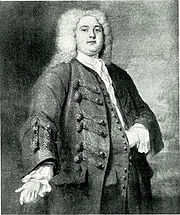 Governor
Wanton He had the background to understand the feelings of the
merchant sea captains of Rhode Island. Governor
Wanton He had the background to understand the feelings of the
merchant sea captains of Rhode Island.
You can understand his merchant background
when you view the a picture which showed him twenty years before the events of 1772. Painted
by John Greenwood in the 1750's, the original of this painting is now in the St.
Louis Art Museum.
Clip on the thumbnail below to enjoy the details of this tavern scene. The
artist included various notable Rhode Islanders, including (all seated at the
table):
Nicholas Cooke,
Esek Hopkins,
Stephen Hopkins, and
Joseph Wanton (the one at the table who has gone to sleep from liquor, and
is being doused with punch).

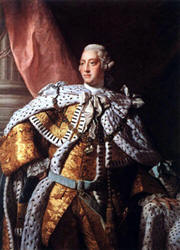 George III.
George III, king of England during the American Revolution, was born in 1738 and
died in 1820. George had high ideals for a king. He sught to rule without regard
to party, to banish corruption from political practice, and to abandon the
German Hanoverian cast of his predecessors to become a king with nothing but the
interests of the kingdom as his object. He was not, however, a good
politician in an age when politics in Parliament drove the country's law and
actions. George III.
George III, king of England during the American Revolution, was born in 1738 and
died in 1820. George had high ideals for a king. He sught to rule without regard
to party, to banish corruption from political practice, and to abandon the
German Hanoverian cast of his predecessors to become a king with nothing but the
interests of the kingdom as his object. He was not, however, a good
politician in an age when politics in Parliament drove the country's law and
actions.
George III was not an autocratic monarch in the sense that his
opponents cast him. However, because of his strong sense of duty toward the
country, despite politically inept actions he was always a powerful force in
politics. He was a strong supporter of the war against America, a war he viewed
as essential to preserve England's empire. Indeed he viewed Parliament's
concession of American independence in 1783 with such detestation that he
considered abdicating his throne.
Likewise, illustrating his strong sense of duty toward the
country, although a Catholic, in 1801 he forced William Pitt to resign as
prime minister rather than permit Catholic Emancipation, a measure that he
interpreted as contrary to his coronation oath to uphold the Church of England.
Twentieth - century scholarship generally found George III to
be a strong-minded but public-spirited monarch, of conservative views. He
used his office as King, in what was then developed into a constitutional
monarchy, with a sense of public duty and private morality that proved popular
in a society that was being being transformed by an evangelical revival and a
popular view of the country as run by popular consent. The English public
generally viewed him as the best of the Hanoverian rulers, a personal reputation
that stood kept high the view of the kingship as good for England.
|








 George III.
George III, king of England during the American Revolution, was born in 1738 and
died in 1820. George had high ideals for a king. He sught to rule without regard
to party, to banish corruption from political practice, and to abandon the
German Hanoverian cast of his predecessors to become a king with nothing but the
interests of the kingdom as his object. He was not, however, a good
politician in an age when politics in Parliament drove the country's law and
actions.
George III.
George III, king of England during the American Revolution, was born in 1738 and
died in 1820. George had high ideals for a king. He sught to rule without regard
to party, to banish corruption from political practice, and to abandon the
German Hanoverian cast of his predecessors to become a king with nothing but the
interests of the kingdom as his object. He was not, however, a good
politician in an age when politics in Parliament drove the country's law and
actions.